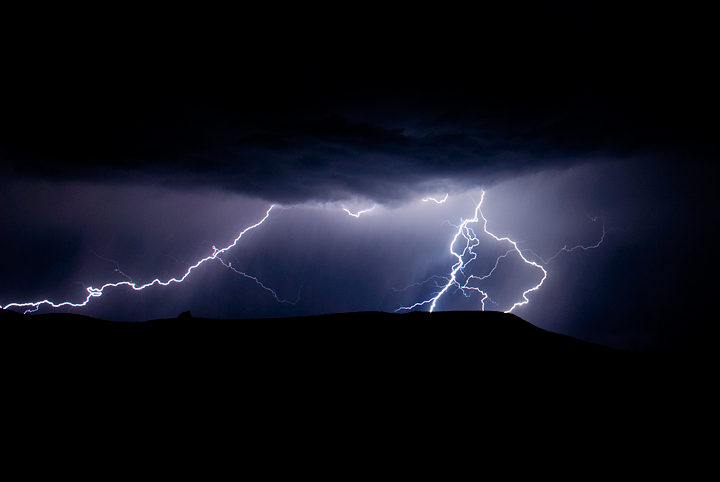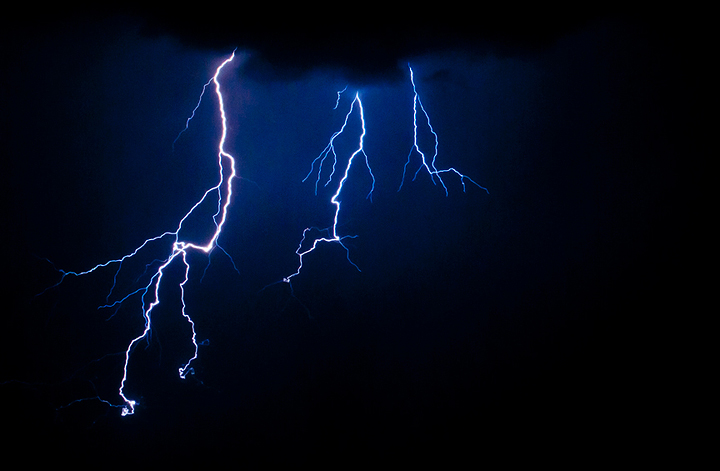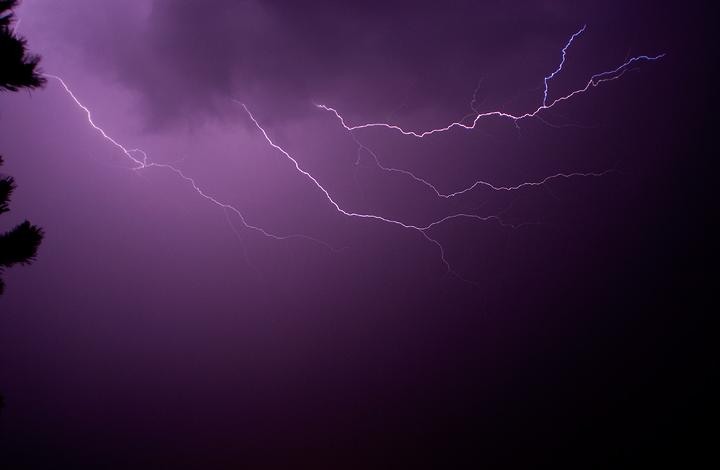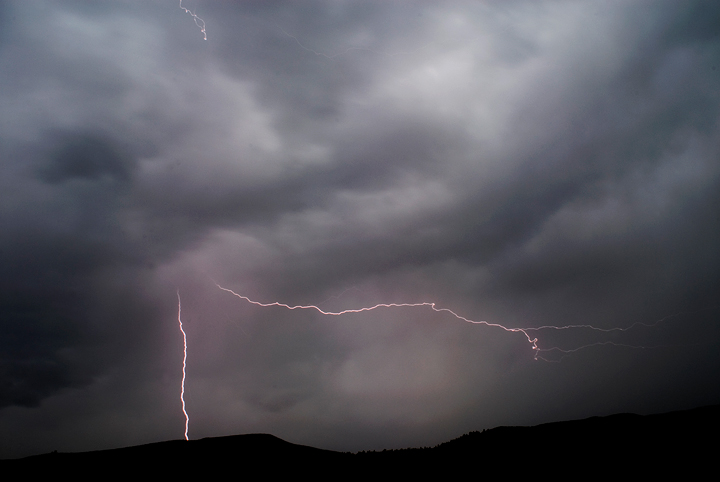add a little zing to your life
 Technique: shooting lightning
Technique: shooting lightning
You could say I have a slight obsession with lightning. Our house faces southwest and in the summer, the southwest monsoons move over us from that direction almost every afternoon like clockwork. I can see the thunderstorms in the distance as they approach, dropping lightning bolts on the Continental Divide and neighboring ridges. Familiar enough with the patterns, I’ve been able to capture some great strikes and more likely than not, miss plenty of other great strikes. When I share my photos, someone will invariably marvel at my presumed quick reflexes and my amazing ability to anticipate the lightning.
multiple cloud to ground strikes (10 seconds, f8, 29mm, ISO 100)

My reflexes are pretty quick, but they aren’t THAT quick. And my anticipation of lightning is as good as my observation that there is a lightning storm in progress. The trick is not to wait to take a snap when you see the lightning, because on average cloud-to-ground lightning discharges on the order of milliseconds. No one is that fast and luck only gets you so far. To achieve consistently decent results, I take the longest possible exposure and do so consecutively throughout a lightning storm.
If you plan to try shooting lightning, there are a few things I’d like to recommend:
1) You’re going to have to shoot on manual.
2) Use a tripod. You’ll need it for all of those long exposures.
3) Go with short focal lengths (wide angle). If you’re just starting out, give yourself a wide field of view to capture any random lightning strikes that may occur around you. Once you become familiar with the storms of a certain area (i.e. they always strike a certain ridge or an isolated microburst is hammering away in one area) then you can tighten the shot and use longer focal lengths.
4) Resolution helps. If you are choosing between your 18 mega-pixel camera and your 8 mega-pixel camera, go with the bigger sensor. The reason? You will most likely crop down to isolate the lightning if you are shooting a wide field. More pixels help to maintain a better image when you crop down.
5) Start with a fully juiced battery. Long exposures drain the battery faster than your typical snaps.
6) Make sure you have plenty of memory. Who knows how long this storm will last? Wouldn’t it suck if you ran out of memory on your flash card only to have the mother of all lightning bolts strike right after your card finished? Yes.
7) If possible, shoot from a sheltered area or safe distance. Thunderstorms are often accompanied by rain, so being able to shoot from the doorway of my deck helps to keep the rain off of my lens until the winds start driving the rain into the house. If you are far enough away from the storm to shoot it in the distance, great. However, keep in mind that being out under an approaching storm (even if it isn’t raining) puts you at an increased risk of getting zapped. If it IS raining and you are outside with an umbrella over your gear during an active thunderstorm, then you’re just asking for trouble (and by trouble, I mean death).
8) Don’t get killed. Lightning is no joking matter. Lightning can carry over a billion volts.
night lightning
Probably the easiest way to shoot lightning is during a nighttime lightning storm. I like to focus just shy of infinity because that’s usually where my local lightning hits, set my aperture to f8 or thereabouts, leave my ISO on 100 (or the lowest native ISO setting), and put the shutter speed on 6 seconds if the storm is active, and up to 20 seconds if the strikes are less frequent. I cannot actually see where I am focused because it’s pitch dark, but I know from daytime experience that this side of infinity works for me on a relatively wide angle (less than 45mm). Same thing goes for field of view. I usually have to futz with my camera and wait for a lightning strike to light up the area so I can frame my field of view. Again, as with most of my nighttime photography endeavors, I like having a red light headlamp so I can see my gear without blinding myself.
I live in a location with minimal light pollution, so dark is truly dark. If I were to take an exposure for 20 seconds at night, it would be mostly black. Now if lightning were to strike in my field of view anytime during that 20 seconds when my shutter was open, it would be captured in my image. If there were two lightning strikes a few seconds apart, but both within the 20 seconds when my shutter was open, I’d have two strikes captured in my image.
forked lightning (20 seconds, f8, 44mm, ISO 100)

Thunderstorms used to catch me off guard, but these days I watch for them. First, I check the weather report for that evening which is wrong a good 50% of the time. Then I check the radar to follow active storms moving our way. Of course, I can also tell when the storm is arriving from the flashes of light in the distance and the rumble of thunder nearing. It’s kind of exciting. As the storm moves over my location, things usually go downhill quickly. For one thing, the rain and winds make it almost impossible to continue shooting (I put the hood on the lens at night, which helps at the start of the rain, but is useless when driving rain is coming right at you). Secondly, when the storm is directly overhead, not only does the rain prevent me from shooting straight up, but I’d have to be outside, under a massive electric potential (that is dangerous).
cloud to cloud (16 seconds, f2.8, 20mm, ISO 100)

Night lightning in dark places is pretty straightforward because you can set your shutter speed to whatever you like. When conditions are lighter, like sunset or dusk, or if there is considerable light pollution coming from city lights, traffic, or even the moon, then I try to take care that my shutter speed doesn’t blow out the other light sources. This means there will be a limit on the shutter speed to achieve proper exposure of the entire image. It makes for a nice composition if you can get those elements in place in addition to the lightning.
storm at sunset (15 seconds, f7.1, 26mm, ISO 100)

evening strike (10 seconds, f22, 20mm, ISO 100)

daytime lightning
Daytime lightning storms are actually more common where I live than nighttime storms, but they pose more logistical problems than capturing lightning at night. A few things are easier to do during the day. I can see where the storms are such that I can manage a pretty precise focus on where the lightning usually strikes. I can tell what my field of view is rather than guessing in the dark. That’s about the extent of the advantages.
approaching storm in the distance, dry and clear overhead

Though skies can grow quite dark when a thunderstorm blows in, they are still bright enough that my maximum exposure, even with the aperture cranked down to f22, is still shorter than 1 second. That kind of window makes it more likely that I will miss a strike. Also, if I have my camera on continuous shooting at a shutter speed of less than 1 second, I will burn through more than 60 images per minute. If I’m lucky, I might manage a capture.
daytime cloud to ground (.5 seconds, f22, 20mm, ISO 100, no filter)

But if my aperture is as small as it can get at f22 (remember that a bigger f-stop corresponds to a smaller aperture), how else can I keep the shutter open longer without drastically overexposing the image? Filters. I have some neutral density filters that I occasionally use for landscape photography and decided to stack a few to darken my scene, thus making it possible to increase my exposure time.
my set up

closer look at the filters

If you just want to dabble around with shooting lightning, I don’t recommend investing a lot of money in a filter system. A cheap circular polarizer will gain you 2 f-stops. I happen to have a not cheap circular polarizer that offers 2/3 f-stop, but I stack that with my ND4 (neutral grey neutral density 2-stop) and my ND-3G-SS (graduated neutral density 3-stop soft-step) filters. These two additional filters are inserted in a Cokin filter system. I have the Z-pro model, to avoid vignetting on wide angles. Here’s how it assembles:
adapter ring for my 24-70mm lens (77mm diameter)

they thread onto your lens or your polarizer

mounted on the polarizer which is mounted on my lens

sliding the filter holder onto the adapter ring

snap the pegs to secure it into place

cokin nd4

slide the nd4 into the first filter slot

see how it covers the front of the lens?

graduated filter nd-3g-ss

slide the nd-3g-ss into the second filter slot

top view

Ideally, I would have another solid neutral density filter instead of the graduated filter, but I’m just making due with the gear that I already have. Because the graduated filter is only half dark, I slide it down so that the dark half is covering most of my view. I don’t mind if it begins to lighten at the bottom, because that’s where the mountains usually are and they’re pretty dark anyway.
using the dark half of the graduated filter

This combination of filters with my circular polarizer on maximum darkening will generally get me anywhere from 4 second exposures under lighter clouds to as much as 10 seconds for the really dark and stormy clouds at midday. The main drawback of using this filter system is that you cannot attach a lens hood which means you are more susceptible to rain getting on the outer filter (and yes, they do show up in the image). Now that my exposure is long enough to my liking, there is one final thing I always connect to my camera for this sort of shoot.
my remote cord/timer

plug it into the 10-pin socket on your camera

This remote cord/timer is nice for a couple of reasons. For one thing, your arm doesn’t get tired pressing the shutter release every N seconds for the duration of a storm. And you can walk away from the camera without missing a single strike (unless it happens right between exposures, which is rare). It isn’t necessary, but if you happen to have a remote cord/timer, put it to good use and slap it on your camera. You’ll be especially grateful for it when you have to make a dash for the potty.
Right, so with all of that, I’m finally ready to shoot. These days it takes me about 2 minutes to get it all set up and ready for a storm. Usually with these afternoon fronts in the distance, I can begin shooting from the deck until the rain arrives or the lightning gets close. At that point, I move inside and stand in the doorway. When it really starts raining, I either move inside a little more or stop shooting altogether (especially if it’s raining so hard that visibility goes down the drain).
camera on deck as the storm approaches

daytime cloud to ground (4 seconds, f22, 55mm, ISO 100, filter, crop)

Here’s an 18-second video I shot on my iphone during a lightning storm. The lightning strike is much faster than the read rate of the iphone, but you can still catch the bolt at 3 seconds. The clicking that you hear every 6 seconds is my camera on the remote timer.
18-second lightning movie
That’s pretty much how I shoot lightning. There are probably great opportunities for capturing lightning in summer all over the place. Just remember that safety comes first. And have fun!
double cloud to ground (4 seconds, f22, 32mm, ISO 100, filter, crop)







August 12th, 2012 at 6:58 pm
Your photography is always so stunning. I see lightning out here quite often and it often makes me think of you. Beautiful stuff.
August 13th, 2012 at 6:34 am
Truly amazing..thank you!!!
August 13th, 2012 at 7:45 am
Thanks for the great tips! Especially about your filter setup. Your shots are amazing and beautiful!
August 13th, 2012 at 3:20 pm
My goodness, those shots are amazing. Put me on your mailer or facebook friends. Love your work!
August 13th, 2012 at 3:45 pm
Thank you for being so generous and sharing your knowledge of food and photography.
August 13th, 2012 at 11:30 pm
[…] how to shoot lightning | use real butter […]
August 14th, 2012 at 12:35 pm
Thank you so much for sharing this! It really helped!! Beautiful!!
August 14th, 2012 at 7:56 pm
Once again, you amaze me Jen! I don’t know how you find time to cook! hugs, jill
August 16th, 2012 at 7:01 pm
Priceless post! I’m zipping M1 a note. She has a fancy pants camera and is ripe for the learning (oh, so is her mama, but I’m a simple point and shoot, prayer-in-the-cloud, type of person). Thank you, once again, for sharing your knowledge.